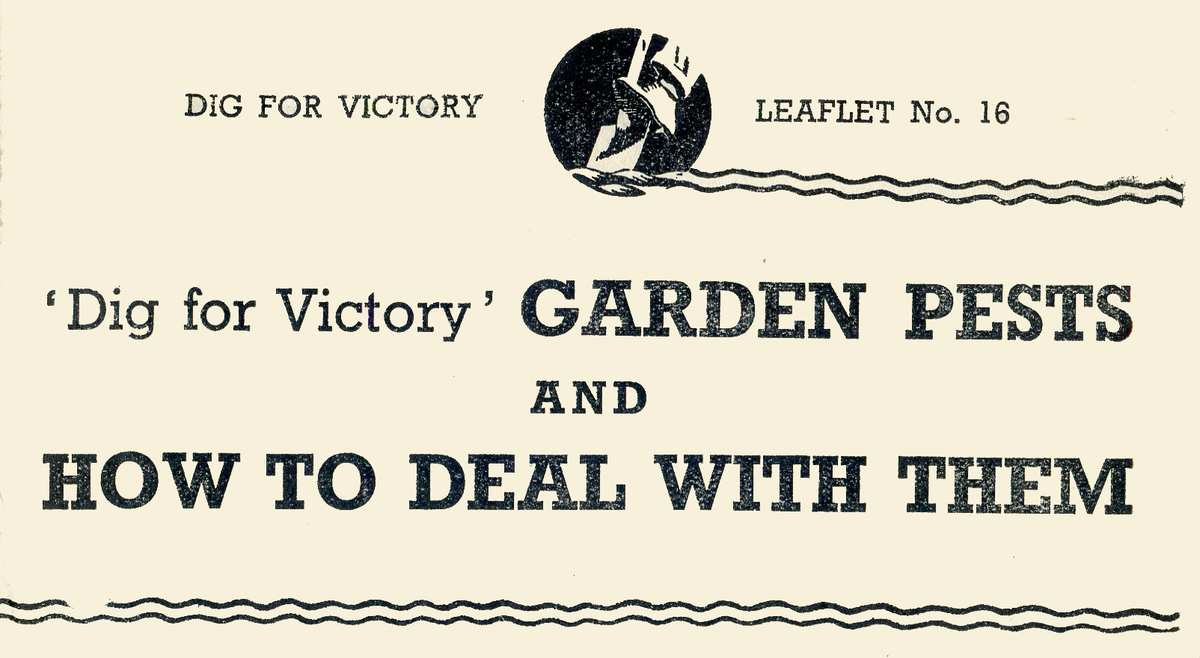 GARDEN PESTS AND HOW TO DEAL WITH THEM
GARDEN PESTS AND HOW TO DEAL WITH THEM
DIG FOR VICTORY LEAFLET No. 16 (Page 3 of 4)
Carrots
In medium and light soils, the Carrot Fly causes great loss and there is no complete remedy. In these circumstances defer the main sowing of carrots until the first half of June. Otherwise, repeated applications (7-10 day intervals) of naphthalene dust from the time the seedlings are above ground until the end of June should give good results, but the treatment is troublesome.
To avoid attracting the fly, carrots should be thinned in the evening and all thinnings removed. Alternatively, seeds can be sown very thinly thus avoiding thinning altogether.
Naphthalene, which was the active ingredient in traditional mothballs, was banned in the EU in 2008.
The best defence against the carrot fly available is fleece or enviromesh covering.
Celery
The leaf miner is often troublesome. As soon as blisters are seen, the affected leaves should be removed and no plants should be put out with blistered leaves still on them. Spraying with nicotine is advisable if handpicking is not alone successful.
Nicotine is highly poisonous and an indiscriminate insecticide, killing friend and foe alike. It is no longer available.
Onions
The Onion Fly is the worst pest of this crop. The best remedies are :
(1) Treat the seed before sowing with calomel. The seed is first moistened with thin flour or starch paste (about ¾ teaspoonful to each 1 oz.) and powdered calomel equal in weight to the seed is added.
Glass, earthenware or enamel containers should be used for the mixing, which should be continued until the seed is uniformly coated with the powder. The seed may be sown at once or be allowed to dry and then stored in a wooden or cardboard container. Treated seed must not be kept in stoppered glass or metal containers.
(2) Apply a 4 per cent, calomel dust along the rows, 1 Ib. being sufficient for 50 yards of row. A small hand-dusting machine may be used, and the aim should be to distribute the dust along the rows and for about two niches on each side.
Two applications should be given, the first when the seedlings are about 1½ inches high and the second about ten days later.
Calomel which is a mercury based insecticide, is no longer available. Netting as for carrots is a defence and where onion fly is a major problem the application of tailored nematodes is very helpful in reducing the population
When, in spite of treatment with insecticides, onions are attacked, the plants should be carefully removed, with the maggots in the soil around them, and burned.
Peas
Seed containing holes caused by the Pea Beetle should be avoided. Pea
Weevils may be dealt with as advised for Bean Weevils, and Greenfly (or Aphides) by spraying with a nicotine or pyrethrum wash.
Where Pea Moth caterpillars are particularly troublesome (spoiling peas in the pod), early and mid-season varieties should be grown, and late sowings, which are usually the most attacked, avoided.
Potatoes
Apart from wireworms and slugs, Potato Eelworm is the worst animal pest, and everything possible should be done to prevent the infection of clean ground.
Where new allotments are made out of grass fields or other land that has not carried potatoes before, all seed potatoes brought in from elsewhere should be washed clean of soil so as to prevent their being a source of infection. The same treatment is also worth while on any established block of allotments that has not already become infested.
In addition, potatoes should be grown only in rotation and the temptation to plant potatoes on the same ground every year should be resisted. Rotation is the best method of preventing the building up of serious infestations, and since there is no cure, prevention is specially important.
Badly infested land will seldom grow a crop worth harvesting, but heavy manuring with farm yard manure or heavy dressings of calcium cyanamide (now hardly obtainable) should give a definite increase in crop and may be justifiable as an emergency measure. Manuring, however, is no substitute for the adoption of a proper system of rotation.
Calcium cyanamide is available today although you may have to hunt around to find it. It’s also sold under the name of Perlka. It isn’t licensed as a fungicide but it does have fungicidal properties and is often used to fertilise cabbage family crops in soils infected with Club Root.
Rotation does help with potato eelworm but to eliminate the problem would require a 7 year rotation and not transferring from the affected area to other areas would be near impossible.
L D Hills, the founder of Garden Organic, believed that growing a crop of green manure mustard after harvesting potatoes was beneficial as it secreted chemicals that confused the nematodes into growth and early maturity out of season.
See Potato Eelworm


